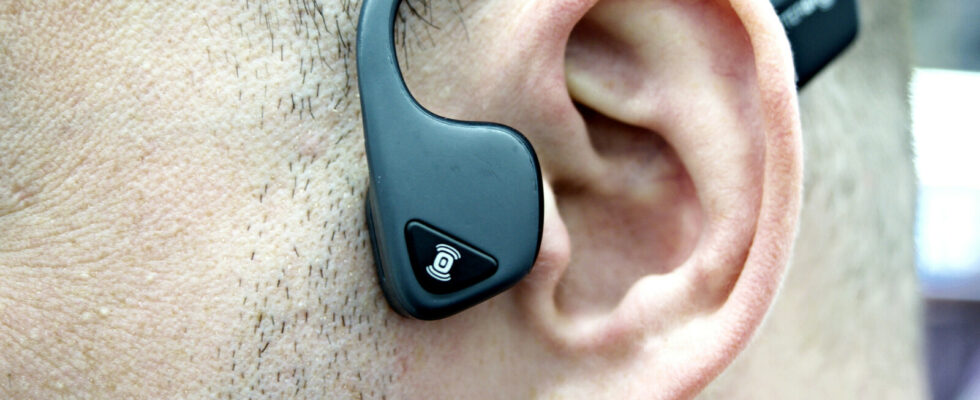In recent years, bone conduction and open-ear headphones have become very popular. We will show you the best models and clarify the advantages and disadvantages of the technology.
- Bone conduction headphones transmit the sound via vibrations via bone conduction via your skull directly to the eardrum.
- This allows you to hear sound even though your ears are completely exposed and can hear ambient noise.
- Such headphones are useful, for example, in traffic or during sports. There is also a recommended alternative technology, open-ear.
Headphones come in many different shapes – in-ear headphones are plugged directly into the external ear canal and fire up your eardrums with your favorite music via small speakers in the outputs. Over-ear or on-ear headphones, on the other hand, lie on the ear or surround it without having to be inserted into the ear. There are also many different intermediate shapes and special designs.
But all of them have one thing in common: your ears are completely or partially covered when you use them, so you can’t hear outside noise. This can be very helpful, for example if you want to switch off in a noisy environment. However, there are two types of headphones that leave your ears completely free – bone conduction headphones and so-called open-ear headphones.
Wearing comfort can also be advantageous. Quite a few people don’t like in-ear headphones, especially models with silicone or memory foam tips that sit firmly in the ear canal. With on- or over-ear headphones, however, you may experience a feeling of pressure or hot ears. This is not the case with bone conduction and open-ear headphones. Below we explain how the devices work and introduce you to the five best models.
How does bone conduction work?
Advantages and disadvantages of bone conduction headphones
How do open-ear headphones work?
Advantages and disadvantages of open-ear headphones
The best five open-ear and bone conduction headphones in comparison
How does bone conduction work?
Bone conduction headphones use the phenomenon of so-called bone conduction, the medical term for this is osteoacusis. This refers to the transmission of sound vibrations through the skull bone that surrounds the auditory organ. The middle ear is completely bypassed – the sound travels directly from the headphones via your skull bones to the eardrum, which absorbs and processes the sound waves.
For this purpose, bone conduction headphones usually have one, sometimes two vibrating bodies per ear, which rest on the bones directly in front of or behind your ear. The small motors in the vibrating bodies process the audio signal into sound vibrations. People around you won’t hear what’s playing on the headphones. You, in turn, can hear all ambient noise as if you didn’t have headphones on your head – because your ear remains free and is not restricted.
Advantages and disadvantages of bone conduction headphones
Based on how they work alone, bone conduction headphones have various advantages, but also clear disadvantages:
Advantages:
- Surroundings can be heard without restrictions: Despite the “transparency modes” that many modern headphones are equipped with, the environment can usually not be heard without restrictions and in its original quality. Bone conduction headphones solve the problem: you can use them to listen to music and hear any noise from your surroundings at the same time. This can be useful in traffic, for example, if you need to be able to hear your surroundings.
- Comfort: Many people find it uncomfortable to wear ordinary headphones for a long period of time. No matter whether heat build-up, pressure caused by noise canceling or in-ear attachments: none of these problems exist with bone conduction headphones. In many cases they are much more comfortable than regular headphones. Bone conduction headphones are also a real help for people who are prone to ear infections.
Disadvantages:
- Sound quality: Since bass and very high tones cannot normally be transmitted so well via bone conduction, the sound quality suffers. Certain frequencies or musical instruments may be displayed incorrectly. The sound quality of a 200 euro bone conduction headphone will never be comparable to that of a 200 euro normal headphone. After all, noise isolation is crucial for the quality of the music – and this is practically non-existent in such devices. Therefore, users of bone conduction headphones have to endure major losses, especially in terms of sound quality.
- Vibration at high volumes: At very high volumes, the vibrating bodies on your bone conduction headphones can actually start to vibrate noticeably. Many users find this irritating.
How do open-ear headphones work?
In contrast to bone conduction headphones, open-ear earphones do not transmit sound via vibrations. Rather, like conventional headphones, they work with a loudspeaker. In open-ear headphones, this is located in front of the ear canal.
In contrast to in-ear, on- or over-ear headphones, the ear canal remains clear and external noises can be heard. In recent months, open-ear models in particular have come onto the market, while bone conduction devices have been rare. Many established manufacturers such as Huawei, Bose and Soundcore have brought their own models onto the market – all of them open-ear.
The design differs significantly depending on the model. There are open-ear headphones that are very similar to bone conduction models – including a neckband. Another design relies on ear hooks – or ear hooks. The OpenRock Pro would be an example here; manufacturer Shokz has a similar model on the market with the OpenFit.
Huawei and Bose, on the other hand, rely on a completely different concept. Your open-ear headphones clip onto the side of your ear. They are hardly noticeable, significantly smaller than the temple models and save glasses wearers from having to touch the temple.
Advantages and disadvantages of open-ear headphones
Compared to bone conduction headphones and also conventional headphones, open-ear headphones obviously also have advantages and disadvantages. We summarize them for you below:
Advantages:
- Unlike bone conduction headphones, open ears can produce better sound.
- Comfort can be better because open-ear headphones do not rest on the zygomatic arch.
Disadvantages:
- The perception of external noise can be less good than with bone conduction headphones because open ears sit in front of the ear canal.
- Compared to conventional headphones, the sound quality is poorer, especially bass.
The best five open-ear and bone conduction headphones in comparison
Below we have selected the five most popular bone conduction and open-ear headphones for you and compared them with each other.
Huawei FreeClip
With a market price of just under 200 euros, the open-ear headphones from Huawei are not a bargain – but the headphones impressed us in our test of the FreeClip. They are very small and are barely noticeable because they are clipped to the side of the ear and weigh less than 6 grams each. Thanks to water protection and good grip, they are ideal for sports, but also in the office. Comfort comes first here, the sound quality is good, but not outstanding. Still a real recommendation for us.
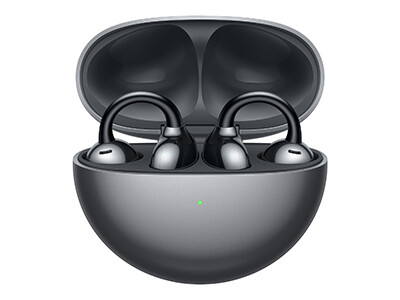
Huawei FreeClip
- Battery life: 8 hours
- Charging time: 40 minutes
- Bluetooth version: Bluetooth 5.3
- Water resistant?: IP54
- Weight: 5.6 grams (per side)
to offer
Bose Ultra Open Earbuds
The Ultra Open Earbuds are the first open-ear headphones from the German audio specialist. At around 350 euros, they are even more expensive than the Huawei FreeClip. The earphones are waterproof, support 3D sound and, according to the manufacturer, should impress above all with their outstanding audio quality. Like the FreeClip, they are attached to the side of the ear and the weight is very low at 10 grams per side. Bose has also integrated an automatic volume control that adjusts the volume depending on the background noise. This function can also be deactivated via the app.
Soundcore AeroFit Pro
Anker now also sells open-ear headphones under the Soundcore brand. What particularly impressed us in the Soundcore AeroFit Pro test was the audio quality. In terms of design, instead of using a bracket design, they are approximately larger than Huawei and Bose, which means that the charging case has also grown. The open ears are delivered with an optional neck strap for an even better fit. The battery life is up to 14 hours, and of course this model is also water-protected and sweat-resistant.
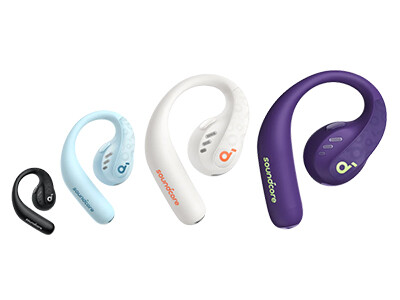
Soundcore AeroFit Pro
- Battery life: 14 hours
- Charging time: 1 hour
- Bluetooth version: Bluetooth 5.3
- Water resistant?: IPX5
- Weight: 12.23 grams (per side)
to offer
Shokz OpenRun Pro
The Shokz OpenRun Pro are around 50 euros more expensive than the basic model of the Shokz OpenRun. For the additional price, customers receive some improvements: The bass in the Pro model has been improved, and the battery life of 10 hours is the longest in our comparison. The microphones have noise cancellation and the fast charging technology has also been improved – the headphones only need an hour to fully charge. These headphones also come in two sizes and the sound is transmitted via Bluetooth 5.1. There is one disadvantage compared to the basic model – the OpenRun Pro are only certified to IP55. The weight is acceptable at 29 grams.
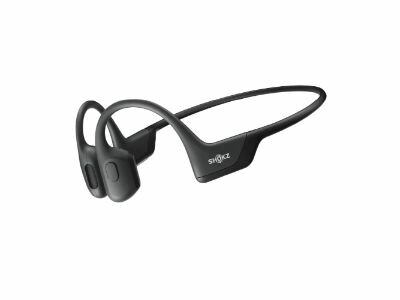
Shockz OpenRun Pro
- Battery life: 10 hours
- Charging time: 1 hour (with quick charge function)
- Bluetooth version: Bluetooth 5.1
- Water resistant?: IP55
- Weight: 29 grams
to offer
Shokz OpenSwim
You may have noticed that we haven’t mentioned a model that is suitable for swimming. Water protection according to IP67, as is available with the OpenRun, is not enough. The Shokz OpenSwim, on the other hand, offer IP68 waterproofing and can therefore be used for swimming up to 2 meters deep. A fundamental difference to the other models, however, is that there is no Bluetooth here – instead, songs are stored on an internal music memory with a capacity of 4 GB (up to 1,200 songs). The OpenSwim can easily be worn with a swimming cap and offers a battery life of eight hours. The weight is 30 grams.
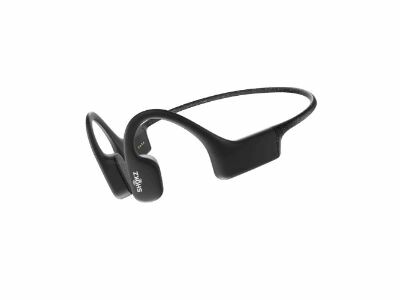
Shokz OpenSwim
- Battery life: 8 hours
- Charging time: 2 hours
- Bluetooth version: No Bluetooth, just integrated music storage
- Water resistant?: IP68
- Weight: 30 grams
to offer
If you want to buy the bone conduction or open-ear headphones primarily for the fitness area, there are alternatives here too. In our comparison of the best sports headphones, we show you the five best headphones for training.
- ” Tip: The best VPN providers for more security and data protection
- » Buy balcony power plant: Comparison of the best solar systems
Don’t miss anything with this NETWORK WORLDNewsletter
Every Friday: The most informative and entertaining summary from the world of technology!
